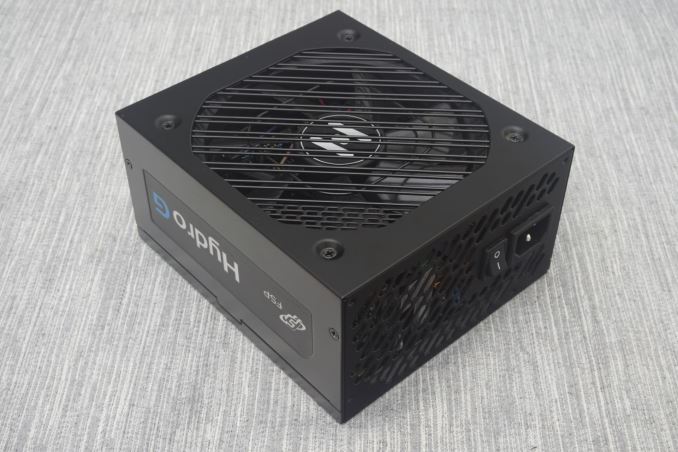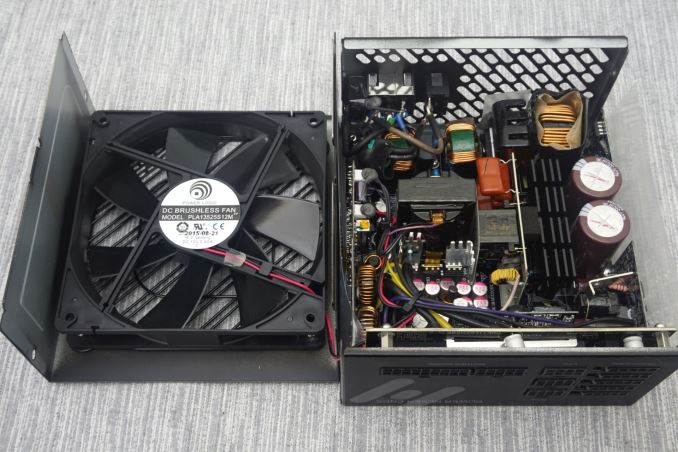The FSP Hydro G 750W Power Supply Review
by E. Fylladitakis on March 3, 2016 8:00 AM EST- Posted in
- PSUs
- Cases/Cooling/PSUs
- 750W
- FSP
- Modular
Final Words
Wrapping things up, FSP designed the Hydro G series specifically to attract advanced users and enthusiasts who want high quality and high performance PSUs, but do not require massive levels of power. More specifically, FSP is hoping that the Hydro G units will find their way into high-end gaming systems that are using up to three high performance graphics cards (two for the 750W version we reviewed today).
As gamers often build for aesthetics as well as performance, FSP spent a considerable portion of their time and resources to design a visually pleasing and unique PSU. The satin black finish may be prone to fingerprints, but it is very smooth and subtle, while many users will appreciate the all-black, flat cables. Our only negative remark lies with the heavily advertised changeable side stickers, which although changable, can only be used once and cannot be removed since they're standard stickers. However they do get the job done, just as long as user is happy with their first color selection.
From an engineering standpoint FSP generally creates high quality products, and the Hydro G is no exception. As a matter of fact, it may very well be a testament to what the company can achieve. The design is very clean and the PSU itself is very well made, using excellent quality components. The five-year warranty may not be extraordinary for a unit of this class, but it certainly is reassuring.
The overall performance of the Hydro G PSU is excellent. Acoustics seem to be the primary focus of the design, as the Hydro G 750W PSU remained inaudible almost across the entire load range in room temperature testing. Nevertheless, FSP is not afraid to ditch the acoustics performance if the temperatures get high, ensuring the stability and longevity of the PSU. The electrical conversion efficiency is not extravagant for an 80Plus Gold certified model, neither is the quality of the power output, but they should be more than satisfactory even for demanding users.
Ultimately the FSP Hydro G is a high quality, very well made product that offers excellent overall performance. It would mostly match the needs of those that want a product that combines aesthetics with good overall performance focused on low noise operation. The current MSRP price of $120 for the 750W version is a little high, considering that many competitive products retail for $10 to $30 less, but the PSU can be found retailing for as low as $80 after rebate, which is a very good deal for such a model.












22 Comments
View All Comments
blahsaysblah - Thursday, March 3, 2016 - link
Not much seems to have changed with the actual PS design forever.PS + UPS in one(just a few minutes to shutdown safely and real surge protection and incoming voltage regulation).
PS combined with a CPU water cooler. They are usually in a key airflow spot in a lot of cases. Reduce noise and make it easier to keep cold air cold by combining two exhausts into one.
kaidenshi - Thursday, March 3, 2016 - link
"PS + UPS in one(just a few minutes to shutdown safely and real surge protection and incoming voltage regulation)."Indeed, I've never understood why we can't have a PSU/UPS combo in a full size PC, especially given the energy density of modern Lithium based rechargeable batteries. Maybe it's a safety issue? But then we've had Lithium batteries in laptops for about 20 years, that's a long time to perfect a design.
nathanddrews - Thursday, March 3, 2016 - link
I think you would both be interested in checking out some of the 5.25" battery backup units on the market. They are a bit niche and hard to find, but basically they are like what you are describing. The battery pack fits in a 5.25" drive bay and the PSU is connected through it.I think the main reason internal UPS aren't popular (outside the server market) is that desktop users have many other external devices connected that may also need to be powered down safely.
FuzionKore - Tuesday, March 8, 2016 - link
Exactly. Why invest in a PSU/UPS combo if your monitor dies anyways and you can't save what you were working on? The money is almost always better spent on a discrete UPS, unless somebody makes a unit with a power output for a monitor.5th element - Thursday, March 3, 2016 - link
Lithium ion batteries need to be kept cool otherwise their performance suffers quite badly. Inside a PSU is about the worst place you could put one.Wardrop - Friday, March 4, 2016 - link
How are you going to save your work and shutdown when your monitor is off? There's also often more to a PSU than just a battery. Adding all that to a PSU would make it quite expensive and extremely niche.Wardrop - Friday, March 4, 2016 - link
Replace the first "PSU" with "UPS".Murloc - Thursday, March 3, 2016 - link
a battery is pricey and useless to most people. What most people could use is a PSU able to survive a brown-out.But even then, it's probably more worth it to replace the PSU if something happens. I've had 1 PSU die on me in my whole life.
xenol - Monday, March 7, 2016 - link
If you're going to have a UPS anywhere, it should be at the mains. As another mentioned, what's the point if you can't see what you're doing?Also wouldn't want water anywhere near a PSU.
asmian - Thursday, March 3, 2016 - link
So it's called 'Hydro', but it's not water-cooled. Apart from generating click-bait product names, what on earth is their marketing team smoking?